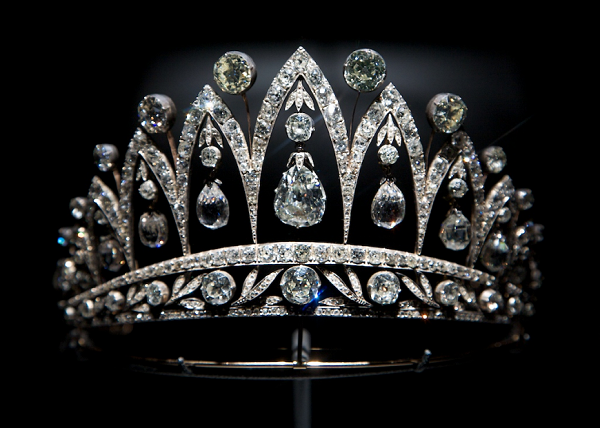 |
| Wikimedia Commons |
One of the things I’ve missed most over the past year is traveling to new cities and strolling through their local museums to look for jewelry treasures. I’m sure I’m not the only one feeling that way, so I thought it would be fun to devote several posts to some of the most glittering royal tiaras found in museums around the world—so we can all feel like we’re traveling again, right from our own homes. Today, we’re kicking things off with a sparkling tiara that has roots in France, Germany, and Russia, and now resides in Houston, Texas: the Leuchtenberg Fabergé Tiara.
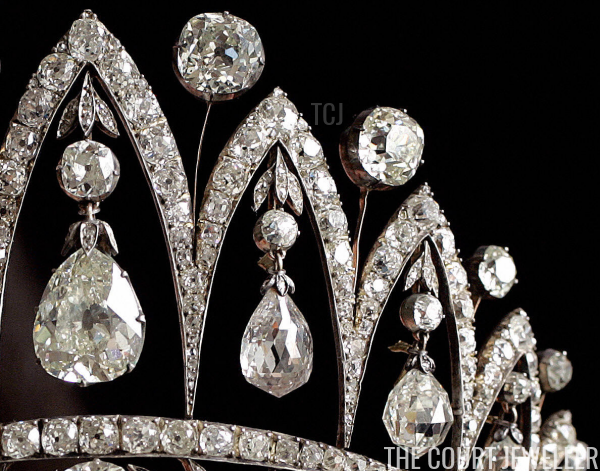 |
| FABRICE COFFRINI/AFP/Getty Images |
The small diamond sparkler features diamonds set in silver and gold, made of pointed arches from which large diamond drops are suspended. More large diamonds, mounted on knife-edge settings, rise between the arches, which rest on a base that features diamond leaves in its design. The delicate tiara was made by August Holmström, the Finnish-born head jeweler for Fabergé, around 1890. But while the entire jewel is certainly worthy of admiration, it’s the briolette-cut diamond drops which really make the piece important.
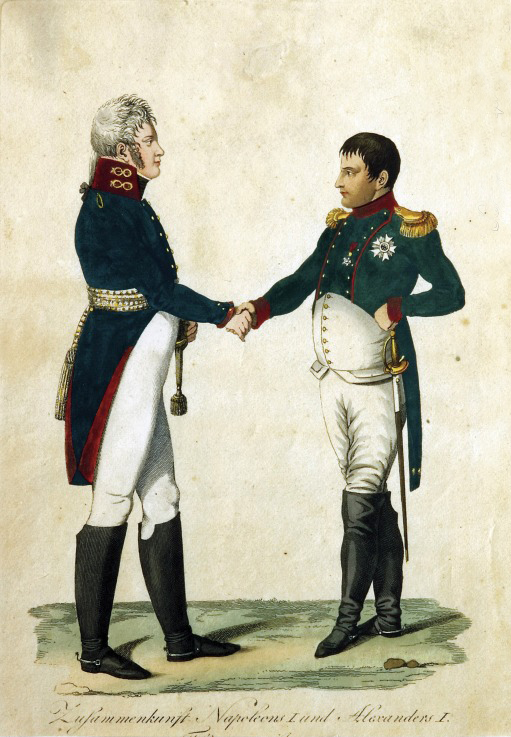 |
| Napoleon and Alexander depicted at the time of the Treaty of Tilsit, ca. 1807 (Wikimedia Commons) |
The diamond briolettes are a souvenir of an unusual and complicated royal friendship. At the start of the nineteenth century, a pair of emperors—Napoleon I of France and Alexander I of Russia—had a chaotic, changeable diplomatic relationship. The young Russian tsar couldn’t seem to decide whether he admired Napoleon or hated him. Alexander (who was a grandson and protégé of Catherine the Great) joined a coalition with Britain to fight against France in 1805, but then, two years later, he changed sides, forming an alliance with France and Prussia.
It seemed as if Alexander and Napoleon might form a genuine friendship for a time, but then the friendly and diplomatic relationships between them cooled. Territorial disagreements, especially where Poland was concerned, were a major flashpoint. And then, after divorcing Empress Josephine in 1810, Napoleon asked Alexander for the hand of his younger sister, Grand Duchess Anna Pavlvona. Alexander declined. (Anna Pavlovna went on to become Queen of the Netherlands instead, and Napoleon married Archduchess Marie Louise of Austria.) The Franco-Russian alliance collapsed. Alexander’s forces defeated Napoleon’s troops during their attempted Russian invasion in 1812, and they joined the rest of the European coalition to defeat Napoleon again in 1814.
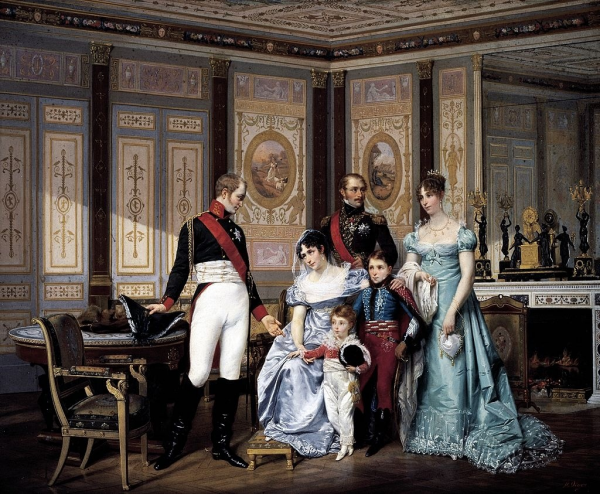 |
| Hector Viger’s painting of Alexander meeting Josephine, Eugène, Hortense, and Hortense’s sons at Malmaison in 1814, painted in the 1860s (Wikimedia Commons) |
Napoleon abdicated in April 1814 and was exiled to Elba. Meanwhile, Alexander (who had led Russian troops into Paris) decided to pay a call to Napoleon’s ex-wife. After the end of fighting, Josephine had returned to Malmaison, her chateau near Paris. Many of the political leaders who had been fighting in France, for various reasons, asked to see her after her former husband’s abdication. Alexander in particular was apparently curious to meet the woman who had so strongly captured Napoleon’s heart and imagination.
Alexander visited Malmaison several times in the spring of 1814, meeting not only Josephine but also her children, Hortense and Eugène, and Hortense’s sons, Napoléon-Louis and Charles-Louis (who later became Napoleon III). The Hector Viger painting above, completed in the 1860s and currently part of the collection at Malmaison, imagines what one of these visits must have looked like. During one of his stops at the chateau, Alexander presented Josephine with a cache of briolette-cut diamonds—the same ones currently set in the Fabergé tiara. They’re a compelling legacy of the Russian emperor’s deep fascination with Napoleon and his extended family.
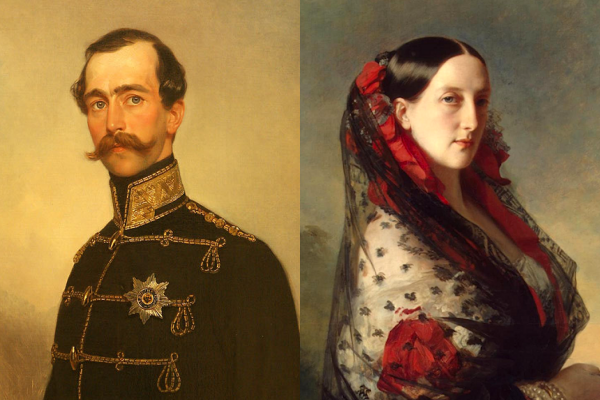 |
| Portraits of Prince Maxmilian, 3rd Duke of Leuchtenberg, and his wife, Grand Duchess Maria Nikolaevna of Russia (Wikimedia Commons) |
Only days after hosting a grand dinner at Malmaison for Alexander and his relatives, during which she took a walk with Alexander in the gardens of the chateau, Josephine became ill and suddenly died. (Alexander had originally planned to attend her funeral in person, but he ended up sending a representative instead; he did, however, go in person to Hortense’s chateau at Saint‑Leu, where he conveyed his condolences to her and to her brother Eugène.)
It seems that the diamonds that Alexander gave to Josephine were inherited by her son, Prince Eugène. He had married Princess Augusta of Bavaria, the daughter of King Maximilian I Joseph of Bavaria, in 1806. In 1817, three years after Josephine’s death, Eugène’s father-in-law granted him the title of Duke of Leuchtenberg. The title was later inherited by both his sons. The elder, Prince August, held the title of Duke of Leuchtenberg from Eugène’s death in 1824 until his own passing eleven years later. Next, the title was inherited by Eugène’s younger son, Prince Maximilian, who had been born just weeks after the Leuchtenberg title had been bestowed on the family.
With Maxmilian, the Leuchtenberg branch of the family found itself relocating, interestingly enough, to Russia. In 1839, Maximilian married Grand Duchess Maria Nikolaevna, the daughter of Tsar Alexander’s brother and successor, Tsar Nicholas I. The emperor had stipulated that, in order to marry Maria, Maximilian would have to relocate to Russia. He complied, bringing his German ducal title, as well as Josephine’s briolette diamonds, with him to St. Petersburg. In return, Tsar Nicholas upgraded him to the style of “Imperial Highness,” something that was necessary to make the marriage equal in the eyes of Romanov dynastic rules. With the marriage, Empress Josephine’s grandson had wed Tsar Alexander’s niece, bringing together the two imperial lines and reuniting the diamonds with the Romanovs.
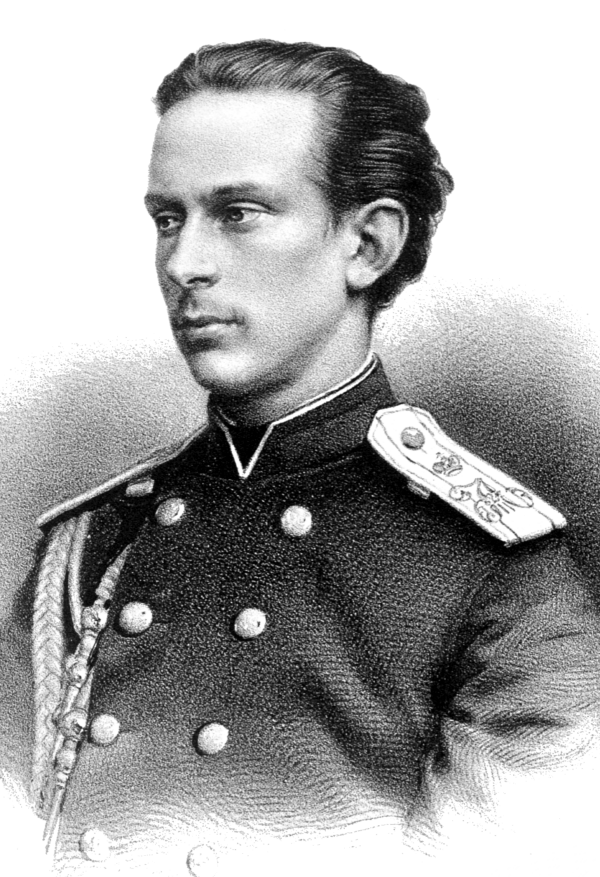 |
| Nicholas Maximilianovich, 4th Duke of Leuchtenberg (Wikimedia Commons) |
Maximilian and Maria Nikolaevna had seven children together, six of whom survived to adulthood, before his death in 1852. The Leuchtenberg dukedom was inherited by Maximilian and Maria’s eldest son, Nicholas Maximilianovich. After serving with distinction in the Russian war against Turkey in the 1870s, he settled in France. Before the war, he had married a divorced woman, Nadezhda Sergeievna Annenkova, in a union that wasn’t approved by the emperor. This morganatic marriage produced a pair of sons, Nicholas and George. Though the relationship violated the house laws of the Romanovs, Nicholas’s cousin, Tsar Alexander III, issued a special edict in November 1890 that clarified the status of Nicholas’s sons. Alexander III established a new Russian creation of the Leuchtenberg dukedom (with the style serene highness) for Nicholas and George.
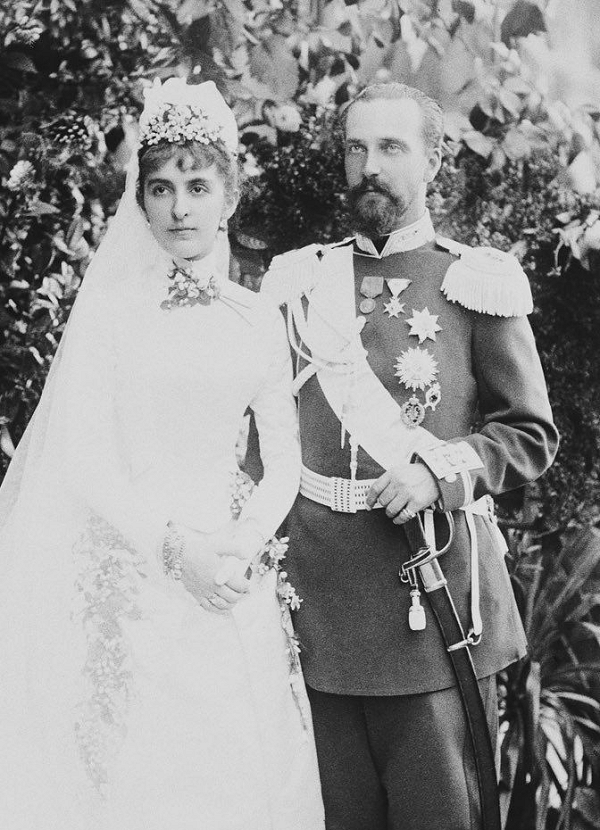 |
| Wedding of Princess Anastasia of Montenegro and George Maximilianovich, 6th Duke of Leuchtenberg, 1889 (Wikimedia Commons) |
When Nicholas died of cancer in 1891, the Bavarian title of Duke of Leuchtenberg passed to his younger brother, Eugene, while the newer Russian Leuchtenberg title passed to his son, Nicholas. Like his elder brother, the new 5th Duke of Leuchtenberg had married morganatically. Eugene’s first wife, Daria, had died giving birth to their daughter; he had subsequently married Zinaida Skobeleva, who had a long and quite public affair with Grand Duke Alexei Alexandrovich, one of her husband’s cousins. (Even though everyone knew about the affair, Zina was made Countess de Beauharnais by Alexander II, and then raised to Duchess of Leuchtenberg by Alexander III.)
The 5th Duke’s morganatic marriages meant that, when he died in 1901, the title passed again to a younger brother. George Maximilianovich, 6th Duke of Leuchtenberg had also married twice, but both times with imperial approval. His first wife was Duchess Therese Petrovna of Oldenburg; after her death, he married Princess Anastasia of Montenegro. That marriage took place in 1889, amid much imperial celebration. I have often wondered whether the creation of the Fabergé tiara was tied to this particular Leuchtenberg wedding. (If so, it’s not necessarily a particularly good omen. Not only was the marriage a rather spectacular failure, Anastasia and her sister were the ones who introduced Rasputin to Empress Alexandra several years later.)
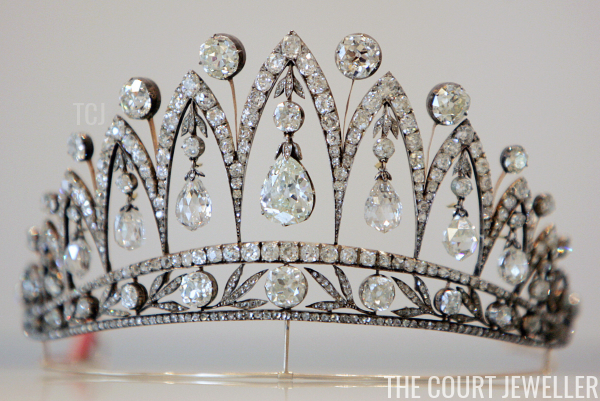 |
| MEHDI FEDOUACH/AFP/Getty Images |
Exactly which one of the 3rd Duke’s sons ended up with the diamond briolettes has never been clear to me, but we know that the diamonds (and the tiara they are set in) stayed in the Leuchtenberg family until World War I. By that time, the title belonged to Alexander Georgievich, 7th Duke of Leuchtenberg (son of the 6th Duke and his first wife, Duchess Therese), who, like the other surviving Romanovs, went into exile. At this point, many members of the family were selling pieces of jewelry to raise money to live on. The Leuchtenbergs, it seems, were no different. The 4th Duke’s son, George Nikolaevich, for example, sold a diamond riviere in Switzerland after the war.
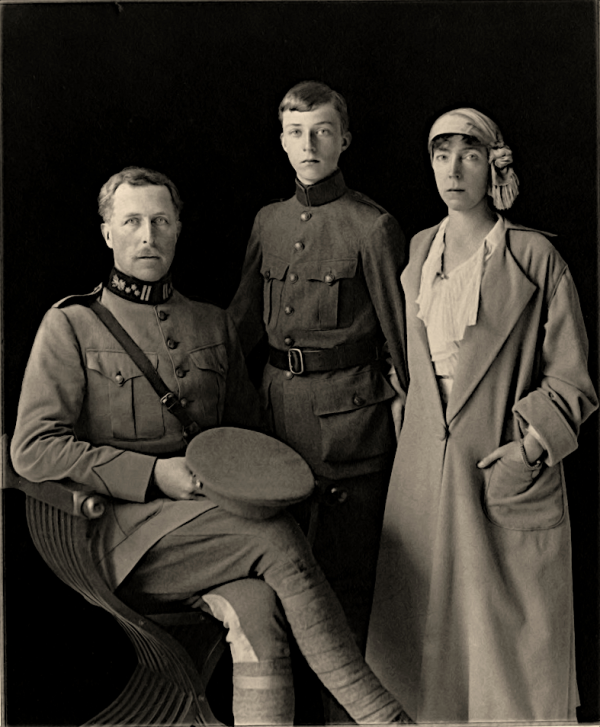 |
| King Albert I and Queen Elisabeth of the Belgians with the Duke of Brabant during World War I (Wikimedia Commons) |
In the war’s wake, the tiny Leuchtenberg Fabergé Tiara was also sold—but to another Beauharnais descendant. King Albert I of the Belgians, who bought the tiara in Switzerland, was a great-grandson of Stéphanie de Beauharnais. She was a first cousin once removed of Alexandre de Beauharnais, the first husband of Empress Josephine (and father of Eugene and Hortense). Napoleon adopted Stéphanie and raised her to the status of a princess; she had subsequently married the Grand Duke of Baden. Albert was a grandson of Stéphanie’s second daughter, Princess Josephine of Baden.
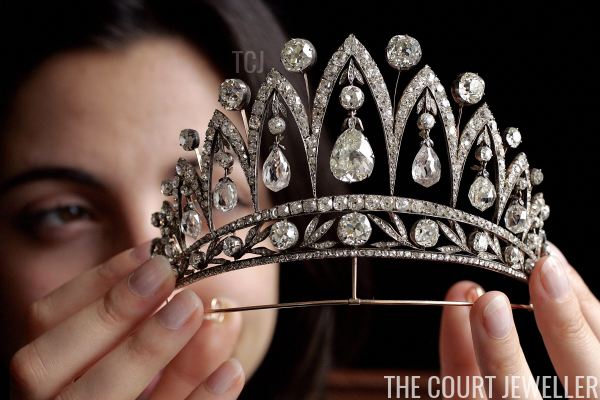 |
| FABRICE COFFRINI/AFP/Getty Images |
Albert’s wife, Queen Elisabeth, was an enthusiastic and inventive jewelry-wearer, but sadly we don’t seem to have any surviving photographs of her wearing the tiny Leuchtenberg tiara. The piece was inherited by the couple’s second son, Prince Charles of Belgium. When he died in 1983 without issue, he bequeathed the tiara to his sister, Queen Marie José of Italy. She died in 2001, and six years later, her daughter, Princess Maria Gabriella of Savoy, decided to sell the Leuchtenberg tiara at auction.
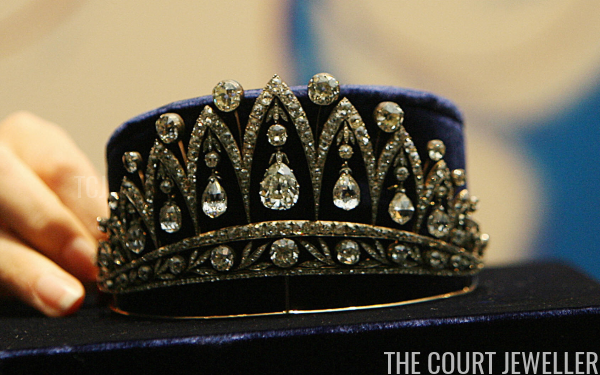 |
| MIKE CLARKE/AFP/Getty Images |
The sale of the tiara was handled by Christie’s in London. Their auction notes for the piece describe the tiara as “designed as a series of graduated old-cut diamond arches with knife edge collet spacers, the central pear-shaped diamond flanked by three briolette and one old-cut diamond, each with diamond collet and leaf surmount to the foliate band, on gold wire frame, mounted in silver and gold, circa 1890, 13.2 cm. wide, with Russian assay marks for gold. Maker’s mark for August Holmström on frame.” When the final bids were in on June 12, 2007, the tiara had far exceeded its auction estimate. Expected to sell for between 400,000 and 600,000 pounds, the tiara sold for an impressive £1,050,400.
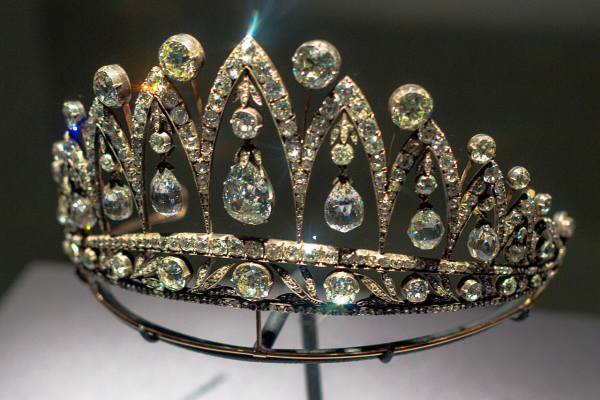 |
| Wikimedia Commons |
We don’t always know who buys these grand royal jewels at auction, but in this case, we do. The tiara was purchased by a pair of American Fabergé collectors, Artie and Dorothy McFerrin. The McFerrins have amassed an amazing collection of Fabergé pieces, which they have generously decided to share with the public. Much of their collection is on display at the Houston Museum of Natural Science, with the tiara in pride of place beside two other Fabergé sparklers. Next time you’re in Houston, don’t forget to stop by to marvel at the tiny tiara—and the briolette diamonds that were part of a world-changing royal dynamic more than 200 years ago.
Have you been one of the lucky ones to see this tiara in person?
Leave a Reply